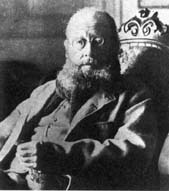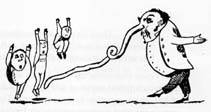
|
LITR 4533: |
|
|
Genre Presentation 2006 |
Sheila
Rhodes
June
22, 2006
Genre
Presentation-The Limerick
Definition
(s):
Limerick
or the genre of Nonsense - A light
humorous, nonsensical, or bawdy verse of five anapestic lines usually with the
rhyme scheme aabba. http://en.wikipedia.org/wiki/Limerick
Limerick:
A light or humorous poem of
five lines. The Merriam Webster Dictionary.
Limerick Example
and Definition
A limerick
is a five-line poem. The first, second, and fifth lines rhyme and so do the
third and fourth. The first, third, and fifth have the same verbal rhythm
(meter) and length, and so do the second and fourth.
http://kabubble.com/limerick_example.htm
There once was a man from Peru,
Who dreamed of eating his shoe,
He awoke with a fright,
In the middle of the night,
And found that his dream had come true!
Laura Black
There was a young lady whose nose
Continually prospers and grows.
When it grew out of sight,
She exclaimed in a fright,
Oh! Farewell to the end of my nose.
The Little Book of Limericks by Warren Lyfick
Although
it is generally believed that Edward Lear devised the limerick,
it is nevertheless, a fact that the five-line poem was around long before
he made popular his nonsense verse. Some claim that soldiers returning from
France to the Irish town of Limerick in the 1700’s invented the Limerick. http://home.earthlink.net/~kristenaa/index.html.
Early
examples
Sections
in poems following the limericks form can
be found throughout known history, from the work of Greek classic poets to the
first known English popular song, Sumer
is icumen in (c. 1300) and the works of Shakespeare. Othello,
King Lear, The Tempest and Hamlet.
These plays all contain limericks
within longer segments. This example is from Othello, Act II Scene
III:
IAGO
Some wine, ho!
[Sings]
And
let me the canakin clink, clink;
And
let me the canakin clink
A
soldier's a man;
A
life's but a span;
Why,
then, let a soldier drink.
The
first deliberate creation to match limerick
form is usually considered Tom O Bedlam c. 1600):
Tom o' Bedlam is the name of a poem written c.1600 about a
Bedlamite (Bethlehem Royal Hospital).
From
the hag and hungry goblin
That
into rags would rend thee
And
the spirit that stands
by
the naked man,
In
the book of the moons defend yee.
Limericks
are meant to be funny. They often contain hyperbole, onomatopoeia, idioms, puns,
and other figurative devices. The last line of a good limerick contains the
'punch line' or 'heart' of the joke.
Limericks
are supposed to be 'fun' rhymes.
Enjoy the rhythm as well as the words and as you say the words, clap your hands
in time with the rhythm.
Subject
Genre:
Expressionist Poetry and Fiction
Narrative
Genre:
Narrator in Rhyme Scheme; Poetry, Comedy
Representational
Genre:
Narration
Sub-genres: Naughty
limericks, nice limericks, loony limericks, children’s limericks, games
containing missing words of the limerick
http://home.earthlink.net/~kristenaa/index.html.
If you go to this page there is a lot of good stuff.
Expressionism: Expressionists reject realism and share the impressionist intention to present a personal vision through art. To render this personal vision artistically, expressionists depict their subjects as they feel or sense or experience them rather that as those subjects appear objectively. To expose idiosyncratic and often extreme states of human consciousness and emotion, expressionist works tend to oversimplify and distort. (The Bedford Glossary of Critical and Literary Terms).
 Edward
Lear is
the man who was thought to
have invented this specific genre.
Most of Lear’s limericks are thought
to be phallic.
Edward
Lear is
the man who was thought to
have invented this specific genre.
Most of Lear’s limericks are thought
to be phallic.
The foremost Lear scholar,
Vivien Noakes, has pointed out, "When Lear was first writing there was no
such thing as an established literary genre of nonsense" (Wanderer
223). Why, then, should not one but two men writing in the mid-1800s
simultaneously yet apparently without knowledge of each other introduce into
English letters what amounted to a new genre, one that has never lost its
popularity? 1 The Victorian collective psyche must have been ready,
somehow, to respond to the irrational characters and patterns depicted in the
Alice (Alice in Wonderland) stories and in Lear's nonsense
limericks, songs, and stories. In his book, Art and the Creative
Unconscious, the eminent Jungian analyst, Erich Neumann, has noted that
"the creative impulse springs from the collective" (98), and that
"although creative men usually live unknown to one another, without
influence on one another, a common force seems to drive all those men who ever
compensate for a cultural canon at a given time or shape a new one" (99).
Such is the case with Carroll and Lear.

All drawings for the limericks are by
Lear.
There was an
Old Man with a nose,
Who said, "If you choose to
suppose
That my nose
is too long,
You are
certainly wrong!"
That remarkable man with a nose.

There was an Old Man with a beard,
who said, "It is just as I feared! --
Two Owls and a Hen,
Four Larks and a Wren,
Have all built their nests in his beard
It is here that we tend to
see the exposed idiosyncratic and extreme states of human consciousness and
emotion, (talked bout in the Bedford Glossary), that Lear, the expressionist,
works tend to oversimplify and distort.
Note for teachers: Have your class to make up their own limericks to see what
they can come up with. This will
help students delve into their imaginations and project their own talent, while
using their imagination and having fun doing so. Have students clap their hands in time to their whimsical
poetry as it is being recited out loud. This
also shows the student that learning can be fun. There is no end to the possibilities of the limerick.
Questions for Discussion:
1.
What was Lear really trying to reveal in his genre of nonsense?
Was he just a guy with a good sense of humor?
2.
Can limericks be considered “real poetry”?
3.
As far as poetry is concerned can this be a useful tool in the classroom?
|
|
|
|

